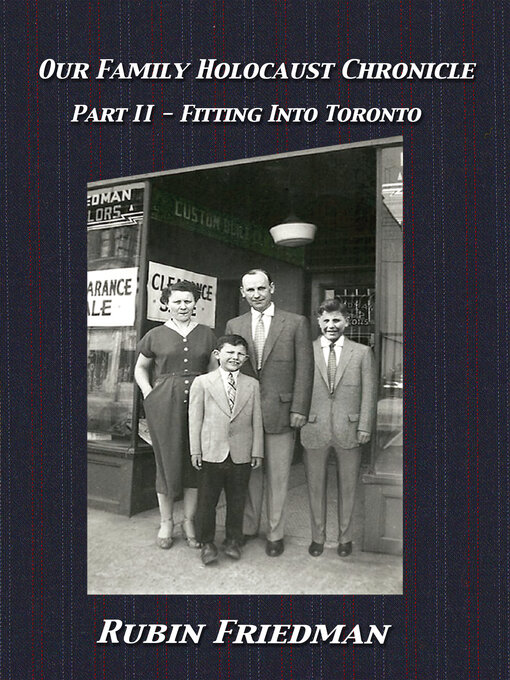This book, Fitting into Toronto – Part II of Our
Family Holocaust Chronicle, is about the complex
downstream aftermath of the Holocaust for my
immediate family, the Friedmans. The impact of
the Holocaust experience on my parents was direct
and most obvious in their behaviours to each other
and to us, their difficulties in integration, as well as
the challenges they faced in being accepted by
others. The repercussions for their offspring, my
brother and me, were inextricably bound up to
these as well as our family narrative of war events,
both what we were told and what we were not.
This along with our own personalities and
propensities in turn had a major influence on our
own interactions with our environment and the
feedback we received from it. All of this came
together to give what I call the long-term effects of
the Holocaust on our family's efforts at fitting into
Toronto and probably on what we have passed on
to our own children.
In Part I of this Chronicle, I recounted the story
of the Lipszyc (Lipschitz) and Fridman (Friedman)
families' escape from Nazi occupied Poland, their
survival in the Soviet Union and their ongoing
search for safety after the Second World War up
until the arrival of the Friedmans at 626 Yonge
Street in Toronto. That tale was a compendium of
stories I had been told by my father (Nuchim-
Nathan), mother (Fayge-Fay) uncle (Harsh Layb-
Harry), aunt (Eda), brother (Shiyeh-Sheldon) and
first cousin (Srulek Dovid-Sheldon), which I fit into
one narrative. In that tale, I appear as Riwen but I
have very limited memory of events up to the point
we arrived on Yonge Street when I was about three
years old.Part II of the Chronicle deals with the period
when I grew up hearing stories of the Holocaust
and the War and watching how what happened in
the past seemed to have drastic effects on my
parents and on us, their children. The story of my
family became more and more my story, so much
so that it felt at times that not only events and
history but personal feelings were being passed on
to me and integrated into my psyche as I became
more aware of myself in the world. Whereas the
point of view in Part I was the result of ongoing
discussion with the main participants, what follows
is told primarily from my perspective, my main
other source being my brother's recollections.
Following, you will find my own story of what
we lived through, combined with fictional stories
that illustrate aspects of our environment and our
interactions with others. These are placed between
the chapters to which they are most relevant. The
c h a p t e r s a r e g e n e r a l l y b u t n o t s t r i c t l y
chronological.
The stories are fictional because they have some
fictional characters with events that are described
in contexts different from those in my life. They are
meant to capture feelings I have had or to illustrate
an aspect of our lives. Sometimes these stories
convey lighter or darker moods than the narrative
itself. Any resemblances to persons living or dead
in those stories aside from my parents, my brother
and myself, are purely coincidental. These stories
will be clearly identified and separated from the
rest of the text. The extracts from my journal and
the transcription of my mother's speech are not
...